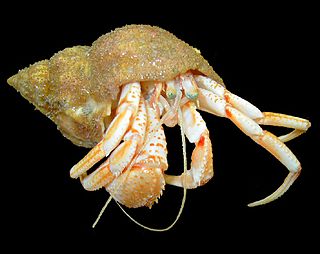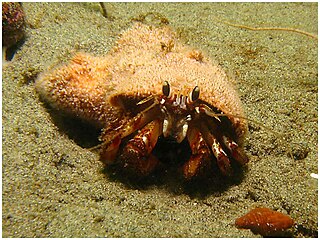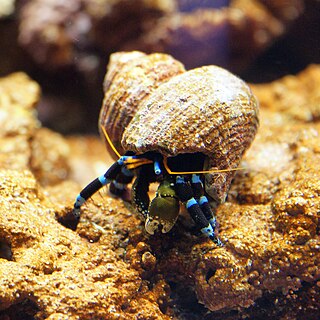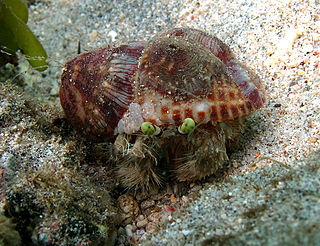
Hermit crabs are anomuran decapod crustaceans of the superfamily Paguroidea that have adapted to occupy empty scavenged mollusc shells to protect their fragile exoskeletons. There are over 800 species of hermit crab, most of which possess an asymmetric abdomen concealed by a snug-fitting shell. Hermit crabs' soft (non-calcified) abdominal exoskeleton means they must occupy shelter produced by other organisms or risk being defenseless.

King crabs are decapod crustaceans in the family Lithodidae that are chiefly found in cold seas. Because of their large size and the taste of their meat, many species are widely caught and sold as food with the most common being the red king crab.

The Coenobitidae are the family of terrestrial hermit crabs, widely known for their land-living habits as adults. They are found in coastal tropical regions around the world and require access to the ocean to breed.

Clibanarius is a genus of hermit crabs in the family Diogenidae. Like other hermit crabs, their abdomen is soft-shelled and sheltered in a gastropod shell. Typically marine like all their relatives, the genus includes C. fonticola, the only known hermit crab species that spends all its life in freshwater. The feeding rates of Clibanarius species change with temperature which, given their broad distributions, may have considerable consequences for the stability reef systems as sea temperatures rise in the future.

The Diogenidae are a family of hermit crabs, sometimes known as "left-handed hermit crabs" because in contrast to most other hermit crabs, its left chela (claw) is enlarged instead of the right. It comprises 429 extant species, and a further 46 extinct species, making it the second-largest family of marine hermit crabs, after the Paguridae.

Petrolisthes is a genus of marine porcelain crabs, containing these extant species:

The Paguridae are a family of hermit crabs of the order Decapoda. The king crabs, Lithodidae, are now widely understood to be derived from deep within the Paguridae, with some authors placing their ancestors within the genus Pagurus.

Pagurus is a genus of hermit crabs in the family Paguridae. Like other hermit crabs, their abdomen is not calcified and they use snail shells as protection. These marine decapod crustaceans are omnivorous, but mostly prey on small animals and scavenge carrion. Trigonocheirus and Pagurixus used to be considered subgenera of Pagurus, but the former is nowadays included in Orthopagurus, while the latter has been separated as a distinct genus.

Calcinus is a genus of hermit crabs in the family Diogenidae, containing the following species:

Paguristes is a genus of hermit crab in the family Diogenidae. It includes the following species :

Dardanus is a genus of hermit crabs belonging to the Diogenidae family.

Dardanus gemmatus, the jeweled anemone hermit crab, is a species of hermit crab native to tropical reefs surrounding the Indo-Pacific, typically at depths of 2–100 metres (10–330 ft).

Dardanus megistos, the white-spotted hermit crab or spotted hermit crab, is a species of hermit crab belonging to the family Diogenidae.
Ciliopagurus liui is a species of hermit crab native to the Gulf of Tonkin and waters to the south of Japan.
Calcinus tubularis is a species of hermit crab. It is found in the Mediterranean Sea and around islands in the Atlantic Ocean, where it lives below the intertidal zone. Its carapace, eyestalks and claws are marked with numerous red spots. C. tubularis and its sister species, C. verrilli, are the only hermit crabs known to show sexual dimorphism in shell choice, with males using normal marine gastropod shells, while females use shells of gastropods in the family Vermetidae, which are attached to rocks or other hard substrates.

The Panopeidae are a family containing 26 genera of morphologically similar crabs, often known as "mud crabs". Their centers of diversity are the Atlantic Ocean and eastern Pacific Ocean.

Dardanus venosus, the starry-eyed crab or stareye crab, is a species of hermit crab in the family Diogenidae. It occurs in shallow water on the eastern coasts of America from Florida southward to Brazil. It is sometimes kept in reef aquaria.
Pseudopaguristes is a genus of hermit crabs in the family Diogenidae.

Dardanus deformis is a species of nocturnal hermit crab that is found in the Indo-Pacific. Its common name is pale anemone hermit. The species is known to transfer sea anemones from one shell to another when it moves to a different shell. It can be kept in an aquarium.

Heterocyathus is a genus of coral of the family Caryophylliidae.

















